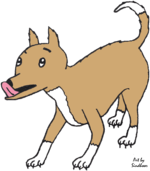Calming signals
Calming signals is a term coined by Norwegian dog trainer Turid Rugaas to describe the signals used by dogs to communicate with each other.[1][2][3][4] According to Rugaas there are at least 30 calming signals. What signals dog use depends on the dog. They may use a subset of these signals. The signals are however universal and all dogs understand all signals even if they do not use them. Dogs are known to use these signals with humans too.
The term has been used by other canine behaviour experts to explain dog behaviour.[5][6][7][8][9][10] Popular dog illustrator Lili Chin has illustrated these signals.[11] There are several others who have illustrated these signals.[12][13][14] Several books on dog behaviour and training now use the term calming signals to describe dog-dog and dog-human communication.[15][16][17][18][19][20][21]
Use of signals by dogs
According to Rugaas, the following is a list of some typical situations that dogs are naturally uncomfortable with and try to communicate their discomfort with calming signals.
- A person bending over the dog
- Direct, prolonged eye contact
- A person's face too close to the dog's face (e.g., kissing on the nose)
- Someone sounds angry
- There's yelling and quarreling in the family
- Someone is walking directly at the dog
- The dog is excited with happiness and anticipation (for instance, by the door, about to go for a walk)
- Someone asks the dog to do something he does not feel like doing
- Training sessions are too long and the dog gets tired
- The dog is confused
- A person hugs the dog
- The dog feels trapped
Examples
Licking/tongue flicks

Licking is a signal that is used often, especially by black dogs, dogs with a lot of hair around their faces, and others whose facial expressions for some reason are more difficult to see than those of dogs with lighter colors, visible eyes and long noses.
Sometimes it is nothing more than a very quick lick, the tip of the tongue is barely visible outside the mouth, and only for a short second. But other dogs see it, understand it and respond to it.
- Lip Licking
-
Dark coloured dogs are likely to lick their lips as a calming signal
-

Lip licking at the camera is typical reaction – a calming signal
Sniffing the ground

Sniffing the ground may look anything like moving the nose swiftly down toward the ground and back up again, to sticking the nose to the ground and sniffing persistently for several minutes.
Turning away/turning of the head

The dog can turn his head slightly to one side, turn the head completely over to the side, or turn completely around so that the back and tail is facing whoever the dog is calming. This is one of the signals seen most of the time in dogs.
When someone is approaching a dog from the front, he will probably turn away in one of these ways. When people or other dogs seem angry, aggressive or threatening, one of these variations of the signal may be seen. When the dog is taken by surprise or takes someone by surprise, he will turn away quickly. The same happens when someone is staring or acting in a threatening way. In most cases, this signal will make the other dog calm down.
- Looking or Turning Away
-

When hugged, dogs turn away. It's a reminder that you are being "impolite" – a calming signal
-

When one dog approaches the other turns away – a calming signal
Play bow
Going down with front legs in a bowing position can be an invitation to play if the dog is moving legs from side to side in a playful manner. Just as often, the dog is standing still while bowing and is using the signal to calm someone down. These signals often have double meanings and may be used in many different ways – often the invitation to play is a calming signal by itself because the dog is making a potentially dangerous situation less tense and diverts with something safe.
When two dogs approach each other too abruptly, you will often see a play bow. This is one of the signals that is easy to see, especially because they remain standing in the bow position for a few seconds.
Walking slowly
High speed can be upsetting to many dogs, and they might want to go in to try and stop the one who is running. This is partly a hunting behavior and is triggered by the sight of a running human or dog. If the one running is coming straight at the dog, it involves a threat and a defense mechanism sets in. A dog that is insecure tends to move slowly. If you wish to make a dog feel safer, then you can move slower.
Freezing

"Freezing" is when the dog stops abruptly and remains completely still, often looking out of the corner of his eye. This behavior is believed to have something to do with hunting behavior – when the prey is running, the dog attacks. Once the prey stops, the dog will stop too. We can often see this when dogs are chasing cats. This behavior, however, is used in several different situations. When you get angry and aggressive and appear threatening, the dog will often freeze and not move in order to help you calm down. Other times the dog may walk slowly, freeze, and then move slowly again. Very often a dog will stop and remain still when someone is approaching. Should a dog be in a conflict situation with a human or dog and is unable to escape, freezing may be one attempt to calm the other dog or person.
Sitting down
To sit down, or an even stronger signal, to sit down with the back turned towards someone – for instance the owner – has a very calming effect. It is often seen when one dog wants to calm another dog who is approaching too quickly. Dogs may sit down with their backs turned against the owner when he or she sounds too strict or angry.
Walking in a curve
This signal is frequently used as a calming signal, and it is the main reason why dogs may react so strongly towards meeting dogs when they are forced to approach head on. Their instincts tell them that it is wrong to approach someone like that. Forcing dogs to approach each other head on can cause them to feel anxious and defensive, and can eventually result in aggressive behavior like barking and lunging at other dogs. Dogs, when given a chance, will walk in curves around each other. This is what they do when they meet off leash and are free to do things their own way.
Yawning

The dog may yawn when someone bends over him, when you sound angry, when there is yelling and quarreling in the family, when the dog is at the vet's office, when someone is walking directly at the dog, when the dog is excited with happiness and anticipation – for instance by the door when you are about to go for a walk, when you ask the dog to do something he doesn´t feel like doing, when your training sessions are too long and the dog gets tired, when you have said NO for doing something you disapprove of, and in many other situations.
Other animals seem to use yawning as a signal too. Humans can use it too to calm down slightly stressed dogs.

"Smiling"
Either by pulling the corners of the mouth up and back, or by showing the teeth as in a grin.

Wagging the tail
Should a dog show signs of anxiety, calming or anything that clearly has little to do with happiness, a wagging tail isn’t always an expression of happiness.
Urinating
Marking objects or locations with urine to claim the space as their own, or simply urinating in place.
Soft face
Making the face round and smooth with the ears close to the head in order to act like a puppy. ("No one will harm a puppy" is what the dog believes.)
Fiddling
Some dogs act like puppies, jumping around and act silly, throwing sticks around, etc. if they discover a fearful dog nearby. This is intended to have a calming effect.
Lying down
Might be seen when puppy play gets too rough. People can use this too by lying down if the dog is getting too excited.
Splitting
This is easy to observe when multiple dogs are interacting with each other. When tensions rise a bit between two dogs, a third dog might try to put his body between the two dogs. Dogs do this when they perceive tensions to rise between people too. If a dog is getting tense about something he sees at a distance, people can step between the dog and the disturbing view to "Split" and achieve the same result

When do dogs stop giving calming signals
According to Rugaas, dogs stop using calming signals in the following situations:
- If they have been punished for using the signals in the past
- If they have been attacked when using them in the past
- If the stress levels are too high
- Pulling on the leash when they are giving the signal to another dog
References
- ↑ Rugaas, Turid. "Calming Signals - The Art of Survival".
- ↑ Rugaas, Turid (2006). On Talking Terms with Dogs: Calming Signals (2nd ed.). Wenatchee, Wash.: Dogwise Pub. ISBN 1929242360.
- ↑ "Canine Calming Signals and Stres". greenacreskennel.
- ↑ "Calming Signals". Facebook - Lost and Found Dogs Virginia.
- ↑ Majchrowski, Mary. "Calming Signals in Dogs and How We Can Use Them".
- ↑ Tripp, Rollan; Tripp, Susan. "What is Canine Communication?". AnimalBehaviour.net.
- ↑ Wilde, Nicole. "Calming Signals".
- ↑ "Canine Body Language & Calming Signals". Pet Potential.
- ↑ "Body Language: Observing and learning from your dog". All Dogs Gym and Inn.
- ↑ Saito, Miki. "Do You Want to Get on Well with Your Dog?". Blind dog training.
- ↑ Chin, Lili. "DoggieDrawings".
- ↑ Yin, Dr. Sophia. "Body Language of Fear in Dogs".
- ↑ Rose, Jez. "Talking Dog".
- ↑ "les signaux d'apaisement".
- ↑ Gross, Patty Dobbs (2005). Golden bridge : a guide to assistance dogs for children challenged by autism or other developmental disabilities. Indiana, Ind.: Purdue University Press. ISBN 155753408X.
- ↑ Ryan, Terry (2011). The toolbox for building a great family dog. Wenatchee, WA: Dogwise Pub. ISBN 1929242794.
- ↑ Ryan, Terry; Mortensen, Kirsten (2004). Outwitting dogs. Guilford, Conn.: Lyon's Press. ISBN 1592282431.
- ↑ Aloff, Brenda (2002). Aggression in dogs : practical management, prevention & behaviour modification. Wenatchee, WA: Dogwise. ISBN 1929242204.
- ↑ Pang, Evelyn; Louie, Hilary (2008). Good dog! : kids teach kids about dog behavior and training. Wenatchee, Wash.: Dogwise Pub. ISBN 1929242581.
- ↑ Cooper, Carlotta (2012). How to listen to your dog : the complete guide to communicating with man's best friend. Atlantic Publishing/Dec. ISBN 160138596X.
- ↑ Brown, Ali (2009). Scaredy dog! : understanding and rehabilitating your reactive dog (Revised ed.). Neffs, PA: Tanacacia Press. ISBN 0976641402.